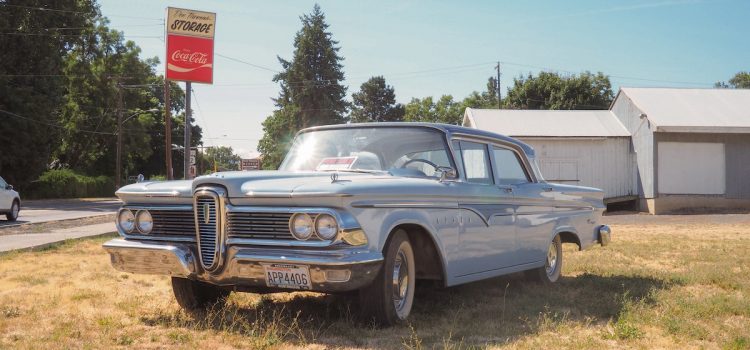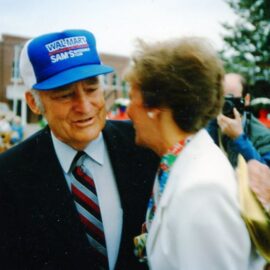

This article is an excerpt from the Shortform book guide to "Business Adventures" by John Brooks. Shortform has the world's best summaries and analyses of books you should be reading.
Like this article? Sign up for a free trial here .
Why did the Ford Edsel fail? What can we learn from this adventure in business?
In the 1950s, Ford Motor Company wasted millions of dollars on the Edsel, a car that is considered one of the biggest product launch failures of all time. In Business Adventures, John Brooks shares his analysis, offering three reasons for the failure.
Continue reading to learn why the Edsel was a flop.
Why Did the Ford Edsel Fail?
Brooks writes that, in 1955, Ford decided to introduce a medium-priced car to get a share of the rising demand for vehicles in that price range. After spending two years and $250 million on research, development, marketing, and PR, the company finally unveiled the Edsel. Unfortunately, the car didn’t live up to the hype and suffered from dismal sales; by 1959, Ford stopped manufacturing it altogether.
(Shortform note: While Ford faced other difficulties after Brooks’ book was published, none of them dealt a fatal blow: In 1982, the company lost $658 million, but earned more than $4 billion over the next two years. In 2008, it lost $14.6 billion—its worst performance in over a century—but eventually found its footing, avoiding bankruptcy and a government bailout. It’s still one of the “Big Three ” automobile manufacturers in the U.S. today (the other two are General Motors and Chrysler) and now has a division dedicated to developing electric vehicles.)
Why did the Ford Edsel fail? Brooks posits that there were a number of factors.
Reason #1
First, the timing was bad: The Edsel might have been what consumers were looking for in 1955, but the market had changed by the time it was released in 1957. Due to an economic downturn, consumer preference had shifted to compact cars, which Ford failed to recognize. (Shortform note: Part of the reason Ford wasn’t able to keep up with the changing times was that the company wasn’t agile enough. This inability to adapt quickly typically stems from indecisiveness, misalignment within the company, and complacency. In No Rules Rules, Netflix founder Reed Hastings details how companies can overcome these hurdles with a streamlined workforce, an efficient feedback loop, and fewer controls that bog down processes.)
Reason #2
Second, the car itself was mediocre. Through flashy ads and promotions, Ford built up expectations for the Edsel, but the car didn’t revolutionize the industry as promised. Early buyers also complained about the Edsel’s subpar quality and reliability. (Shortform note: The Edsel is proof that even a huge marketing effort isn’t enough to carry a bad product. Entrepreneur and author Gary Vaynerchuk asserts that a great product can generate the kind of word-of-mouth advertising that a bad product can’t.)
Reason #3
Third—and perhaps the most damning—the egos of Ford’s executives, designers, and marketers blinded them to the actual demands of the market. Even though the company conducted extensive market research to determine what kind of car consumers were looking for, designers went ahead and created a car based on what they thought consumers would like. And, despite commissioning an ad agency and a Pulitzer Prize-winning poet to come up with names for the car, Ford executives disregarded all name suggestions and arbitrarily named the vehicle after Henry Ford’s only son.
(Shortform note: While society tends to think of ego—a combination of ambition, confidence, and a strong vision—as an important ingredient to success, Ryan Holiday argues that it actually leads to failure. In Ego Is the Enemy, he writes that ego causes people to overestimate their skills while underestimating threats and challenges. In the case of the Edsel, Ford’s executives didn’t prepare for failure because they didn’t even consider it a possibility.)
Brooks writes that, despite the Edsel being one of the biggest and most expensive flops in history, Ford executives didn’t acknowledge their missteps, with some even blaming the car’s failure on fickle consumers. They also tended to look back on the experience with nostalgia and fondness. Perhaps they could afford to—Ford managed to survive and even thrived with later releases such as the Falcon and the Mustang. (Shortform note: Some assert that although some executives failed to honestly assess the reasons behind Edsel’s failure, eventually the company’s management did examine those factors, and in doing so, set the company up for future success. By evaluating why the Edsel failed, Ford was able to distinguish a new market segment and designed cars that appealed to this market.)

———End of Preview———
Like what you just read? Read the rest of the world's best book summary and analysis of John Brooks's "Business Adventures" at Shortform .
Here's what you'll find in our full Business Adventures summary :
- A collection of essays about the unpredictability of corporations and Wall Street
- How businesses and economies can rise and fall based on people’s behavior
- A look at the major events that shaped the financial world as we know it







I don’t like to admit it, but look at nearly all of the American made cars in the late 70s to the early 90s were not very reliable cars. with very little if any exception
I was in the car biz in the early 70s – bought and sold several personal cars and trucks from those years. …Drove tens of thousands of carefree miles and hauled boats and horses. Are you sure you’re focusing on the right country?
2611 23, Have deja-vue when reading EV articles . . . Or am l reminded of the Ford Edsel story ? . . .